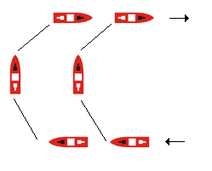Turn around
The turn of the battle was a maneuver of a naval unit that was often drilled, especially in the Imperial German Navy . With this maneuver, a formation running in the keel line could turn in a short time and go on the opposite course while restoring the keel line.
In principle, all ships in the formation turned to the same side, made a 180-degree turn and then formed a keel line again on the opposite course, whereby the last ship in the line at the beginning was now the first and vice versa.
However, this maneuver, which is simple in principle, requires an exact timing to be carried out. If the ships do not turn exactly at the same time, the distances between the ships change. If the ship in front at the beginning of the maneuver begins its turn earlier than the one following it, it completes its turn earlier and is from then on on course to the point where the following ship will end its turn. Because of the short distances between the individual ships in the keel line, there is a high risk of collision in this case, which means that evasive maneuvers have to be carried out, which in turn will lead to a breakup of the formation. With a broken formation, however, a task force can neither be led effectively nor fight in a coordinated manner. Since it is not possible to restore a formation during a battle, it would be lost if the maneuver failed.
Before the introduction of voice radio , there was initially no possibility of sufficiently synchronizing the turning of the individual ships, since within the keel line visual signals (with flags or headlights) could only be seen by the ship directly in front of and behind the signaling ship. They then had to repeat the signal for the next ships in the line, etc. For this reason, the maneuver was generally considered to be practically impracticable.
However, the German Navy managed to solve the problem in a simple way: the signal to carry out the maneuver was passed through from ship to ship. If the last ship in the keel line received the signal, it turned. Every other ship turned now as soon as it could be seen that the ship following it had initiated its turn. In this way the ships did not begin to turn at the same time, but with a slight delay from back to front. Since in this case the ships in the rear turned earlier than the ships in front, there was no risk of collision, as this increased the distances between the individual ships. The keel line has been characterized though protracted, but this was an acceptable price for the execution of the maneuver, since it is an effective counter-maneuvers for crossing the t showed. With the help of the turnaround, the majority of the German navy managed to escape twice in the Battle of the Skagerrak from the Royal Navy's actually devastating "Crossing the T" .
literature
- Reinhard Scheer : Germany's deep sea fleet in the world war. Personal memories. Scherl, Berlin 1920 online (550 MB) p. 226

